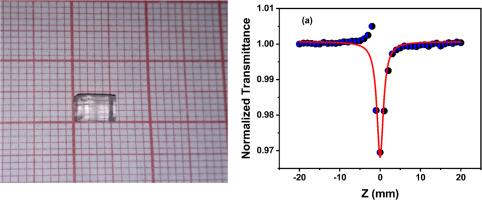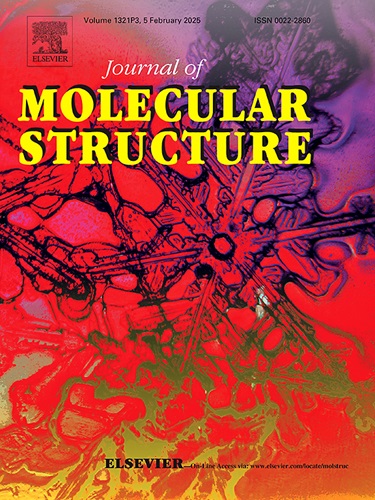Crystal growth, linear optical, thermal, mechanical and third-order nonlinear optical properties of 1,3-diphenyl prop‑2-en-1-one single crystals
IF 4
2区 化学
Q2 CHEMISTRY, PHYSICAL
引用次数: 0
Abstract
This work brings out the viability of the chalcone derivative (E)-1,3-diphenyl-2-propen-1-one (DPP) for industrial applications in nonlinear optical technology and device fabrication, through investigations on its crystal structure and nonlinear optical properties. The unit cell features of the DPP single crystals grown by slow evaporation solution growth method have been determined and hkl values indexed. The optical transparency of DPP in the near infrared and visible range is found to be admirable and an optical bandgap of 3.42 eV is revealed in the UV–Vis-NIR analysis. The work hardening coefficient () of DPP, determined as 2 from Vickers microhardness measurement, shows the moderate mechanical strength of the crystal. The Laser Damage Threshold value of 3.9 GW/cm2 sheds light on the high tolerance of DPP to optical damage and suggests its suitability in device fabrication. The potential of DPP crystal in nonlinear optical applications is suggested from its superior value of 1.16×10−7 esu for third order susceptibility and appealing values of other nonlinear optical parameters.

1,3- 二苯基丙-2-烯-1-酮单晶体的晶体生长、线性光学特性、热学特性、机械特性和三阶非线性光学特性
通过研究查尔酮衍生物 (E)-1,3-二苯基-2-丙烯-1-酮 (DPP)的晶体结构和非线性光学特性,本研究揭示了该衍生物在非线性光学技术和器件制造领域的工业应用可行性。研究人员确定了采用缓慢蒸发溶液生长法生长的 DPP 单晶的单胞特征,并对 hkl 值进行了索引。研究发现,DPP 在近红外和可见光范围内具有良好的光学透明度,紫外-可见-近红外分析显示其光学带隙为 3.42 eV。根据维氏硬度测量结果,DPP 的加工硬化系数 (n) 为 2,这表明该晶体具有适中的机械强度。激光损伤阈值为 3.9 GW/cm2,这表明 DPP 晶体对光学损伤具有很高的耐受性,并表明其适用于器件制造。DPP 晶体在非线性光学方面的应用潜力来自于其 1.16×10-7 esu 的超高三阶电感值和其他非线性光学参数的诱人值。
本文章由计算机程序翻译,如有差异,请以英文原文为准。
求助全文
约1分钟内获得全文
求助全文
来源期刊

Journal of Molecular Structure
化学-物理化学
CiteScore
7.10
自引率
15.80%
发文量
2384
审稿时长
45 days
期刊介绍:
The Journal of Molecular Structure is dedicated to the publication of full-length articles and review papers, providing important new structural information on all types of chemical species including:
• Stable and unstable molecules in all types of environments (vapour, molecular beam, liquid, solution, liquid crystal, solid state, matrix-isolated, surface-absorbed etc.)
• Chemical intermediates
• Molecules in excited states
• Biological molecules
• Polymers.
The methods used may include any combination of spectroscopic and non-spectroscopic techniques, for example:
• Infrared spectroscopy (mid, far, near)
• Raman spectroscopy and non-linear Raman methods (CARS, etc.)
• Electronic absorption spectroscopy
• Optical rotatory dispersion and circular dichroism
• Fluorescence and phosphorescence techniques
• Electron spectroscopies (PES, XPS), EXAFS, etc.
• Microwave spectroscopy
• Electron diffraction
• NMR and ESR spectroscopies
• Mössbauer spectroscopy
• X-ray crystallography
• Charge Density Analyses
• Computational Studies (supplementing experimental methods)
We encourage publications combining theoretical and experimental approaches. The structural insights gained by the studies should be correlated with the properties, activity and/ or reactivity of the molecule under investigation and the relevance of this molecule and its implications should be discussed.
 求助内容:
求助内容: 应助结果提醒方式:
应助结果提醒方式:


